Welcome to “The Ultimate Guide to Dry Pasta Production Lines,” where we explore the complex processes and technologies of dry pasta manufacturing. This guide aims to give readers a better understanding of the essential production lines in the pasta industry. We will look at everything from quality raw material selection to cutting-edge extrusion, drying, and packaging equipment. By reading this article, you will learn how these production lines work, what challenges manufacturers face, and innovations pushing the industry forward. If you are an expert in your field or just interested in making some noodles yourself, this guide is meant for you as a starting point in your journey into dry pasta production.
What Is a Dry Pasta Production Line and How Does It Work?
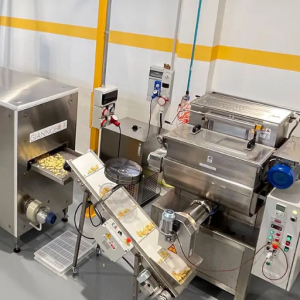
Image source: https://www.pamaroma.com/
A dry pasta production line is a setup that can be found on-site, which helps automate the process of manufacturing dried noodles. It usually has four primary parts, namely mixing equipment, extruders, dryers, and packers. Mixing semolina or flour with water forms dough that passes through different dies used when shaping various types of spaghetti before they come out looking like fettuccini or macaroni, etc., after which it moves onto ovens explicitly designed for removing moisture content, thus improving shelf life while giving them crunchy texture instead! Finally, packaged pasta gets ready for sale repeatedly using advanced tech that guarantees efficiency standards without compromising quality levels, whether made by big companies or small ones producing artisanal goods only occasionally.
Understanding the Basics of Dry Pasta Production
A sequence of steps is carefully coordinated to ensure quality and efficiency when producing dry pasta. The process begins with choosing high-quality durum wheat semolina, which is essential in building the pasta’s structure and flavor. When sourced, semolina flour is mixed with specific amounts of water until a homogenous dough forms. This dough goes through an extruder, which forces it through different molds, such as spaghetti or macaroni, among other shapes.
The next stage after extrusion for most types of shaped pasta would be drying them under controlled temperatures, which gradually removes moisture from them. It is an important step because it influences the texture and shelf life of stored cooked noodles later. Once dried out completely, cooled off, and then packed by machines using automated methods like vacuum sealing against oxygen exposure, they are preferred here because they help maintain quality during transportation over long distances around different regions worldwide without spoiling anything inside packages containing these products being sold at stores everywhere nowadays! Such streamlined processes ensure not only preservation but also efficient distribution to customers who want tasty meals made from their favorite kinds of Italian cuisine dishes prepared quickly at home whenever hungry after work hours every day and all year! Knowing what happens behind the scenes while making your beloved food gives you a deeper understanding of this art form and its advanced technology.
The Role of a Pasta Machine in the Production Line
Pasta machines make, shape, and cut the dough in production lines. The machines ensure a consistent mixture of semolina and water to give the dough the correct elasticity and texture. Pasta machines can produce many shapes, from standard noodles to new designs, while keeping size and thickness the same due to interchangeable attachments and dies. Moreover, intelligent technology is incorporated in modern pasta makers, which automate drying by managing crucial factors such as temperature or humidity for improved efficiency or product quality. By implementing these devices into their assembly lines, companies can speed up production processes, lowering labor costs and allowing them to meet rising consumer demand for different types of pasta.
Key Components in a Dry Pasta Production Line
Dry pasta production lines comprise important parts that make good quality noodles. Firstly, a mixer must combine semolina flour with water until it becomes a uniform dough. Then, the extruder compresses this mixture, forcing it through various shaped holes and creating different macaroni shapes. Afterward, the continuous sheets are cut into smaller pieces by cutters before they are sent into dryers where controlled conditions reduce moisture content, ensuring long-term storage ability, followed by vacuum sealing packaging techniques that maintain freshness over being used at the last stages when dealing with final products meant for sale on markets among other things related to food industry businesses worldwide today! All these components are important; their effective integration leads to better outcomes within any given system involving large-scale manufacturing operations aimed at producing edible items like spaghetti efficiently without compromising quality standards concerning taste preferences, especially among diverse populations inhabiting our planet Earth presently.
How to Choose the Right Machinery for Dry Pasta Production?
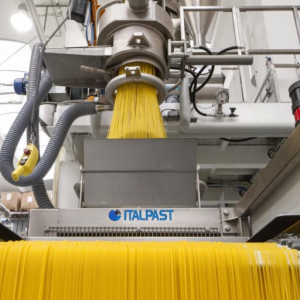
The selection of machinery is critical when it comes to dry pasta production. You must first determine how much you will produce because different machines have varying capacities; therefore, equipment should be chosen based on output requirements. After this step comes evaluating what kinds of noodles you want to make since some devices are designed specifically for specific shapes or sizes.
Another important consideration when choosing machinery for dry pasta production involves looking at its technology and features, such as automation possibilities, user-friendliness, and energy efficiency. Additionally, one must look into the reliability and maintenance needs of the machine, together with reputation and customer support from the manufacturer. Last but not least, don’t forget your budget – though remember that higher efficiency might save long-term costs and lower operational expenses, too! All these points taken into account will help ensure optimal choice when it comes to finding suitable equipment for achieving desired production goals.
Evaluating Pasta Production Capacity
When evaluating how much pasta can be produced, there are three main aspects: machine output, operational efficiency, and production scheduling. An excellent way to measure this is by checking the weight of each machine’s output in kilograms per hour against what you want them to make. According to my research on modern machines for making pasta, they can produce anywhere from 300 kg/h up to more than 2000 kg/h, depending on their design and quality.
Next, investigate operational efficiency by assessing the time cycle for mixing, extruding, drying, and packaging in the production process. High-efficiency machines that eliminate bottlenecks should minimize downtime, thus increasing overall capacity within these systems.
Lastly but equally important is effective production scheduling, which plays a crucial role in maximizing capacity. This involves aligning machinery use with market demand management maintenance schedules so as not to disrupt training staff sufficiently for the efficient operation of all equipment involved herein. These considerations will enable you to optimize your ability to meet customer needs regarding pasta supply levels.
Selecting Machinery for Different Pasta Shapes
When choosing equipment for different types of pasta, it is important to consider each type’s specific requirements and how adaptable the equipment is.
- Type and Extrusion Process: Different pasta shapes, such as penne, fusilli, or spaghetti, require different extrusion dies. Manufacturers can use machines with interchangeable dies to make many different pasta kinds without investing much more money.
- Ingredient Quality: The machinery should work with all kinds of flour and semolina because various types of pasta may require different recipes. To achieve your noodles’ desired texture and flavor, ensure that selected machines can efficiently process certain recipes and blends.
- Integration into Production Line: Consider where this machinery will fit into an existing production line. Overall efficiency and product turnaround times improve when machines easily integrate with both upstream processes—such as mixing—and downstream ones, like packaging.
These considerations allow you to select equipment that satisfies present manufacturing requirements while offering future shape diversification options.
Considerations for Automating the Pasta Processing
Automation can greatly improve the efficiency and consistency of pasta processing across different production lines.
- Workflow Analysis: First, a comprehensive workflow analysis should be performed to pinpoint bottlenecks and areas where automation may produce maximum productivity gains. Familiarizing oneself with current procedures will assist in choosing appropriate automated systems that meet specific requirements.
- Equipment Compatibility: The new automated machines must easily work with what is already there. For effective installation, they need to complement other equipment so as not to disrupt operations or cause delays due to downtime.
- Scalability: Look for automation solutions that can grow alongside your production demands. If you have machinery that can be easily changed as market needs change, you won’t need expensive upgrades or replacements later when things become outdated.
- Data Management and Tracking: Automated systems can improve data collection and analysis, which provides insights into production efficiency, quality control, and maintenance needs, among other things. Such information is invaluable when making informed operational decisions.
- Training and Maintenance: Staff should be trained to operate new automated systems and carry out proper maintenance practices on these machines. This ensures personnel can maximize the benefits derived from automation while minimizing the chances of operational errors occurring due to workers following incorrect usage instructions.
Processors who carefully consider such factors stand a better chance at successfully implementing automation aimed at boosting productivity levels without compromising quality standards throughout its life cycle until it eventually becomes obsolete due to technological advancements over periods longer than expected planned initially for by professionals working within this field across different countries around the world today.”
What Are the Steps Involved in the Dry Pasta Production Process?
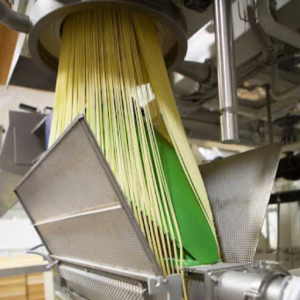
The steps for creating dry pasta are as follows:
- Mixing: To form a dough, durum wheat semolina is combined with water to ensure consistency and hydration level.
- Kneading: The dough is worked so that gluten can develop, giving structure and texture to the pasta.
- Sheeting: Thin sheets of dough can be cut into different pasta shapes, such as spaghetti, penne, or lasagna.
- Drying: Moisture content must be reduced by drying the cut pasta in controlled conditions. This step is essential for achieving the desired texture and prolonging shelf life.
- Cooling and Packaging: Pasta should cool down after drying before being packaged for distribution to keep its quality and freshness intact.
Every step is important to produce high-quality dry pasta that meets consumer expectations and market standards.
From Raw Materials to Finished Product
Every single step in going from raw ingredients to finished products is vital if quality is to be guaranteed. First, semolina flour and water are chosen based on their quality since they directly influence the flavor profile and texture of the final product. After this has been done, a uniform mixture consisting of flour plus liquid will result after mixing and kneading, which causes gluten development, leading to the elasticity required for idealistic noodle-making processes. Next, extrusion occurs where different shapes, like spaghetti or penne, can be made from the dough. Controlled drying occurs when the moisture content is reduced, increasing shelf life potentiality. When completely dried up, cooling happens so no more vapor remains trapped inside before tightly sealing off the ready shipment, ensuring the best condition upon arrival for end users worldwide who love eating delicious pasta prepared using various methods with lots of creativity involved during the cooking process!
Importance of Pre-Drying and Drying Processes
Pasta production involves processes such as pre-drying and drying, which play an important role in determining the product’s quality, texture, and shelf life. In pre-drying, moisture content is regulated to avert spoilage while maintaining the structural integrity of the pasta. This step helps maintain a desirable texture since the pasta should not be too soft or excessively dry. The next step reduces moisture even further, making it possible for the pasta to be stored without going bad while preventing microbial growth. Good drying also improves how well the pasta cooks by allowing it to rehydrate evenly when placed in boiling water, thus providing users with a pleasurable eating experience. Altogether, these steps are necessary for creating high-quality noodles to satisfy consumer demands for freshness and flavor convenience.
Quality Control and Ensuring Consistency
Quality control during the production of pasta is essential to guarantee every batch meets set standards regarding taste, appearance, and feel. Regular testing at different stages throughout manufacturing processes forms part of this practice ranging from checking raw materials used through mixing dough consistency monitoring among others involved herein such as moisture analysis or texture profiling before packaging takes place so they can tell if its fit enough for sale afterwards since there are standardized recipes followed plus environmental conditions controlled carefully throughout all times ensuring end product uniformity between batches produced constantly over time irrespective of who made them; besides calibration done regularly on machines used within factories where workers trained adequately should be able produce top notch pastas without fail because each staff member knows their specific roles assigned towards achieving common goal here – which means delicious meals served hot from pots cooked slowly simmering gently bubbling away inside kitchens around world everywhere people love eating spaghetti bolognese carbonara fettuccine Alfredo lasagna ravioli gnocchi etc., so long as manufacturers prioritize these measures then they’ll have no problem meeting consumer expectations thereby upholding brand reputation consistently year after year eternally until infinity beyond space-time continuum!
Which Types of Pasta Can Be Made on a Dry Pasta Production Line?
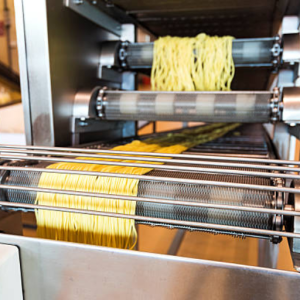
A dry pasta production line can produce many different types of pasta that vary in shape and size. Long varieties include spaghetti, fettuccine, and linguine; short varieties include penne, fusilli, and macaroni, while specialty shapes include farfalle and orecchiette. The line can also make filled pasta such as tortellini or ravioli, but these may need special equipment for stuffing. The flexibility offered by a dry pasta production line allows manufacturers to respond to diverse consumer preferences across various markets without compromising on efficient production methods.
Diverse Pasta Shapes and Their Processing Requirements
Different kinds of pasta enhance visual appeal and affect cooking time and texture. Common long forms like spaghetti or fettuccine typically require standard drying processes, which ensure uniform moisture removal. In contrast, shorter forms such as penne or macaroni may be better suited to different drying conditions due to their thicknesses or surface areas. Specialty shapes like farfalle require careful extrusion processes to create unique appearances, which might mean using particular tools within the manufacturing process.
Meanwhile, filled pasta processing often involves additional stages, including preparing fillings and assembling the dough pockets around them, sometimes needing machines specifically designed for this purpose. Factors such as optimal extrusion speeds and drying temperatures are determined by the physical properties of each shape so that they meet the quality standards expected from cooked products after completion. Therefore, understanding these factors allows producers to adjust techniques accordingly to produce a wide variety of pasta that is appealing enough to buyers’ tastes.
Production Lines for Short and Long Cut Pasta
Production lines for short—and long-cut pasta are distinctively configured due to their different attributes. Manufacturers utilize continuous extrusion processes, which produce long pieces of spaghetti or linguine with little breakage during production. As such, these shapes usually have their drying systems set up in extensive drying chambers where temperature and humidity are precisely controlled to guarantee uniformity in drying while preserving the integrity of the pasta.
On the other hand, penne and rotini belong to a category known as short-cut pasta, whose preparation involves methods that consider their smaller lengths and varying diameters. Multi-staged dryers that accommodate shorter pasta’s moisture retention characteristics are commonly found in production lines for these shapes. Moreover, the mixing and extruding processes used when making short-cut pasta can be different, requiring changes in blending speeds and pressures so that the pasta takes on the correct shape and texture. Knowing these differences within each type helps producers streamline their production lines, making better products efficiently and guaranteeing availability throughout restaurants all over town.
Customization Options for Gluten-Free Pasta
Different consumer preferences have led to many options for gluten-free pasta. Alternative flour sources are rice, quinoa, and chickpea flour. They can also add different flavors and textures to the pasta besides being gluten-free. Manufacturers may include xanthan gum or guar gum in their recipes to make the dough more elastic and better resemble traditional wheat-based noodles.
In addition, there is an increase in experimenting with various shapes and cuts of gluten-free pasta, which broadens buyers’ choices. Some companies might produce fortified gluten-free macaroni enriched with vitamins and minerals to make it more nutritious. Producers should adopt these personalization methods to satisfy the growing demand for such items while ensuring quality remains high throughout production.
How to Maintain and Troubleshoot a Dry Pasta Production Line?
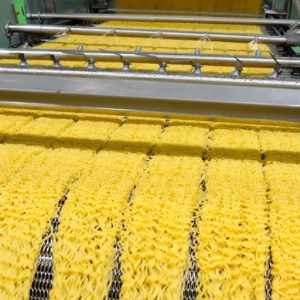
Regular inspections and cleaning are important for proper functioning in a dry pasta production line. Key activities involved in maintenance include checking worn-out parts and replacements, lubricating machines, and monitoring temperatures and pressures during the extrusion process. Raw materials need to be consistent with each other while being stored appropriately so that they do not absorb moisture.
When there are problems with production, troubleshooting should begin by identifying any abnormalities in the texture or taste of the pasta. Some of these issues might be undercooked or overcooked noodles, often linked to wrong temperatures used during cooking or incorrect extrusion speeds applied to the dough. Many different types of problems can arise from this method, but adjusting them and ensuring your dough has enough moisture will solve all your worries about perfect spaghetti again! Also, remember to always check manufacturer guidelines before doing anything else because sometimes things get complicated regarding machinery repairs. Special knowledge is only available through technical support teams who know what’s up! Keeping an eye out for potential signs indicating trouble ahead is key if you want your business running smoothly without hiccups now and then, like some old car engine that keeps stalling at red lights everywhere you go, so make sure everything gets done correctly here, people – trust me on this one.
Regular Maintenance Tips for Optimal Performance
- Scheduled Inspections: To detect and address damage before it becomes a problem, regularly inspect all machinery and equipment at predetermined intervals. Create a log for these inspections and any measures taken.
- Cleaning Protocols: Dust, debris, and residue build up on machines over time, affecting their performance and hygiene within the work environment. Daily or weekly cleaning schedules should be established using appropriate cleaning agents safe for use in food production areas.
- Lubrication and Calibration: As per the manufacturer’s recommendations, ensure all moving parts are properly lubricated. Particularly during extrusion processes, regularly calibrate machines to maintain accuracy in measurements/settings.
- Monitoring Systems: Machine temperature, downtime, production output—just some of the KPIs you could monitor using such systems! This kind of data tracking makes it possible to identify patterns leading to equipment failure/inefficiency.
- Employee Training: Best practices for maintaining and operating machinery should be taught continually throughout employment. The more empowered employees feel about spotting issues early on, the less downtime overall!
Producers who follow these maintenance tips will have better reliability and dry pasta production lines that work better. This means fewer disruptions in business activities while improving the quality of products.
Common Problems and Their Solutions
- Overheated Machines: Equipment failure and decreased productivity can result from overheating equipment. To prevent this, make sure that cooling systems are working correctly. Frequently inspect coolant levels and change filters as needed for better airflow.
- Dough Consistency Problems: Different measurements or inappropriate device settings may lead to inconsistent dough quality. To fix this, standardize your ingredient ratios and calibrate mixing equipment regularly to ensure uniformity while preparing the dough.
- Extruders That Are Clogged: Production delays caused by extruder blockages increase machinery wear. To avoid this, supervise feeding rates and maintain clean extruders. A routine cleaning schedule and inspections will help ensure optimal flow, thus reducing the chances of clogs.
When production lines run smoothly, they guarantee high-quality products if common problems are addressed efficiently.
Using a Contact Form for Technical Support
A contact form for technical support helps quickly streamline the process of dealing with inquiries and problems. It allows users to give detailed information about their issues, ensuring that the support teams have enough background to help well. Here are some key advantages:
- All Communication in One Place: A contact form gathers all support requests in one spot, making it easier for tech teams to handle them and decide on priority levels. This results in faster response times and higher customer satisfaction.
- Collecting Information Effectively: Companies can get relevant data by designing a strategic contact form with specific fields such as problem description or urgency level without having back-and-forth exchanges, thus improving diagnosis speed.
- Tracking Progress Better is Easier: Automated tracking systems are often included with contact forms so users can be sent confirmation of submission and updates regarding request status. This kind of transparency builds trust and keeps users updated.
With an efficiently structured contact form, organizations increase their capabilities in technical assistance while enhancing overall client experience.
Frequently Asked Questions (FAQs)
Q: What are the primary components of a complete dry pasta production line?
A: A complete dry pasta production line typically includes a pasta production machine, pre-dryer, shaker, spreader, actual dryer, and room for packaging. These components ensure the pasta is evenly dried and packed for distribution.
Q: How does the pasta drying process work in dry pasta lines?
A: The pasta drying process involves gradually reducing the moisture content of the pasta through controlled heat and airflow. The dryer regulates temperature to ensure the surface of pasta is evenly dried, preventing cracks and ensuring consistent quality.
Q: Can gluten-free pasta be produced using the same pasta production machines?
A: Gluten-free pasta can be produced using the same pasta production machines, but strict cleaning protocols are required to avoid cross-contamination. Specialized gluten-free pasta lines or dedicated machines are recommended for consistent quality.
Q: What types of pasta can be produced on short-cut pasta production lines?
A: Short-cut pasta production lines can produce various shapes, such as penne, rigatoni, fusilli, and macaroni. The shape of the pasta is determined by the die used in the pasta production machine.
Q: Can fresh pasta production be integrated with dry pasta lines?
A: Fresh pasta production can be integrated with dry pasta lines, allowing for a diversified pasta plant. While fresh pasta lines focus on producing and packaging fresh pasta, dry pasta lines concentrate on drying and packaging shelf-stable pasta products.
Q: What is the role of the shaker in creating high-quality pasta?
A: The shaker helps evenly distribute and separate pasta strands before drying. It ensures the pasta does not clump together, promoting even drying and maintaining its integrity.
Q: How important is semolina flour in the production of pasta?
A: Semolina flour is crucial in pasta production as it provides the right texture, taste, and nutritional quality. It helps form the desired structure of different types of pasta and is essential for the production of classic Italian dry pasta products.
Q: What is considered high temperature in pasta drying, and why is it important?
A: The high temperature in the pasta drying process typically ranges from 85°C to 100°C (185°F to 212°F). This is important because it reduces drying time, ensuring efficient production and preserving the texture and flavor of the di pasta secca (dry pasta).
Q: Is making long and short-cut pasta on the same production line possible?
A: While it is theoretically possible to make both long-cut and short-cut pasta on the same production line, it usually requires different dies and adjustments in the machinery. Dedicated lines for long-cut and short-cut pasta are generally preferred for optimal efficiency.
Q: What equipment is essential in producing lasagne in a pasta plant?
A: The essential equipment for producing lasagne includes a pasta mixer, extruder, laminator, pre-dryer, dryer, and packaging unit. The laminator helps explicitly create the thin, wide sheets of pasta needed for lasagne.














